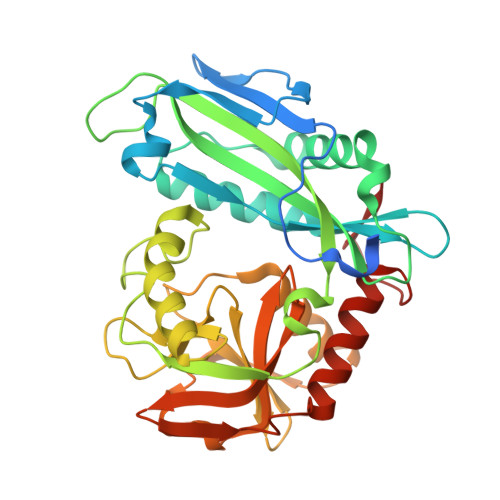Biochemical and structural characterization of a highly active branched-chain amino acid aminotransferase from Pseudomonas sp. for efficient biosynthesis of chiral amino acids.
Zheng, X., Cui, Y., Li, T., Li, R., Guo, L., Li, D., Wu, B.(2019) Appl Microbiol Biotechnol 103: 8051-8062
- PubMed: 31485690
- DOI: https://doi.org/10.1007/s00253-019-10105-9
- Primary Citation of Related Structures:
6JIF - PubMed Abstract:
Aminotransferases (ATs) are important biocatalysts for the synthesis of chiral amines because of their capability of introducing amino group into ketones or keto acids as well as their high enantioselectivity, high regioselectivity. Among all ATs, branched-chain amino acid aminotransferase (BCAT) can use branched-chain amino acids (BCAAs) as substrate, including L -valine, L -leucine, and L -isoleucine, with α-ketoglutarate to form the corresponding α-keto acids and L -glutamate. Alternatively, BCATs have been used for the biosynthesis of unnatural amino acids, such as L -tert-leucine and L -norvaline. In the present study, the BCAT from Pseudomonas sp. (PsBCAT) was cloned and expressed in Escherichia coli for biochemical and structural analyses. The optimal reaction temperature and pH of PsBCAT were 40 °C and 8.5, respectively. PsBCAT exhibited a comparatively broader substrate spectrum and showed remarkably high activity with bulked aliphatic L -amino acids (k cat up to 220 s -1 ). Additionally, PsBCAT had activities with aromatic L -amino acids, L -histidine, L -lysine, and L -threonine. This substrate promiscuity is unique for the BCAT family and could prove useful in industrial applications. To analyze the catalytic mechanism of PsBCAT with the broad substrate spectrum, the crystal structure of PsBCAT was also determined. Based on the determined crystal structure, we found some differences in the organization of the substrate binding cavity, which may influence the substrate specificity of the enzyme. Finally, conjugated with the ornithine aminotransferase (OrnAT) to shift the reaction equilibrium towards the product formation, the coupled system was applied to the asymmetric synthesis of L -tert-leucine and L -norvaline. In summary, the structural and functional characteristics of PsBCAT were analyzed in detail, and this information will be conducive to industrial production of enantiopure chiral amino acids by aminotransferase.
Organizational Affiliation:
College of Life Sciences and Technology, Xinjiang University, Urumqi, Xinjiang, 830046, People's Republic of China.















